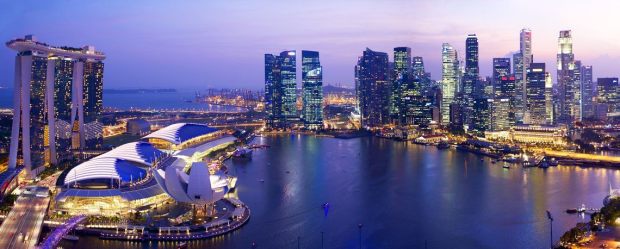Why Tang Da Wu?
Tang Da Wu is a Singaporean contemporary visual artist.
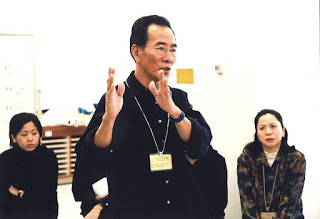
He is also known as being one the leading contemporary artist in the small country of Singapore. I am not going into the details about his biography (my next article will deal about that) but here are the key points you can easely remember :
Tang Da Wu was born in 1943 in Singapore. He began his real artist career in 1970 after his first solo exhibition of drawings and paintings at the Singapore Chinese Chamber of Commerce and Industry.I will go further about Tang Da Wu’s life in the following article.
I decided to choose Tang Da Wu because he inspirated many artists in Singapore. His influence in such a small place is remarkable. For example, he has founded The Artist’s village which is the main contemporary art group in Singapore. He helped his friends and artists develop their artistic skills in a creative good environment. At which point he became a true precursor of singapourean art. I have also chosen him because he is the second singapore artist who has been acclaimed for his work. In 1999 he received the Fukuoka Arts and Culture prize; five years after his compatriot, the Professor Wang Gangwu. For that he is considered as a pionner of performance art in Singapore. I have made my choice not only thanks to his background or the high market value of his art but simply because of the work he created throughout his career (he is still alive).
One other thing that fascinated me is his diversity in his works. He works in a wide variety of types of arts such as drawing, painting, scultures, etc. One of this works that really impressed me is Tiger’s Whip (if you want to see it, just go down), a sculpture of a tiger climbing a chair on a red carpet.

I was able to see this famous word because it is currently is exhibited in the Singapore art museum. By the way, i can give you the advice to attend some exposeures in this museum, it is very interesting and costs only 5 singapourian dollars. This tiger is also one of the emblematic animals of singapore with the lion. Indeed, as you can see with the second photo, the coat of arms of the city state of singapore are the lion and the tiger. Tang Da Wu did not forget his country of birth.

This work first stroke me (why a red carpet, a tiger and a chair in the same work ?) and made me feel unconfortable.
Then the link of his work with singapore was evident. And after looking at the rest of his work, his diversity and his importance in the culture of singapore, I started thinking about choosing him as the main artist of my blog.
I hope we will enjoy the next seven articles about Tang Da Wu.
What influenced Tang Da Wu
Many facts or historical aspects can explain the different works of Tang Da Wu : why he did that, what he wanted to mean. Tang Da Wu was born in Singapore, in 1943, it means during the Japanese occupation. Here is a picture showing the tragic day of the arrival of japanese army. It Will lead, as you can see on the next picture to a period of terror. This period lasted 3 years from 1942 to 1945 and
Changed the Life of every singaporean citizen, And more generally south-asian people under the authority of japanese army.
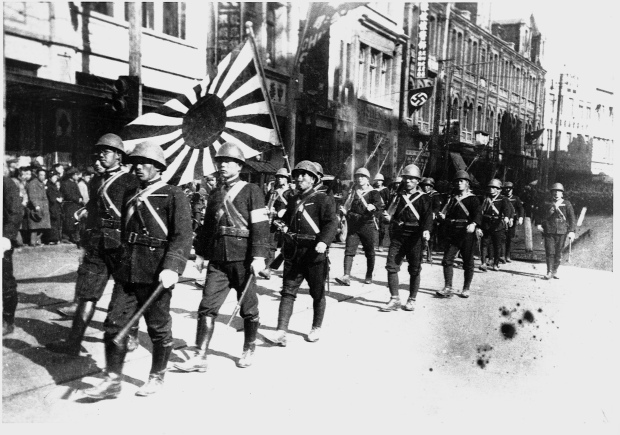
He studied and grew up mostly in UK and he is very concerned about environmental and social issues. At least, it can explains many thing in his works. The western countries were indeed, at that time more aware about this kind of issues than asian countries. That also explains the choice of Tang Da Wu to study there.
For example, about the Japanese occupation and cultural identity, the work « I Was born Japanese » is a very good example. I am sorry to put the light on such a terrible picture. We have to be aware of the period in which Tang Da Wu was born. This picture showing japanese solfiées looking dead singaporeans bodies is relevant on this purpose.

Tang Da Wu himself said he has four nationalities. Of course he is singaporean since the independance of singapore in 1965 but also Japanese because he endures the japanese occupation (from 1942 to 1945) for 2 years. Moreover, he is a British citizen, first of all because Singapore was under the authority of UK after WWII but also because Tand Da Wu studied a long time in UK. He used to say he loved this country. Finally, he was also a malaysian citizen since Singapore joined the federation of Malaysia in 1963, before independance. So the themes of national and cultural identities are really present in his works.
About environmental issue, a very good example is shown by his famous work, the tiger’s whip, whose the picture is attached in the first article. Indeed, the tiger suffers from massive hunting by chinese. They believe that the tiger’s penis has aphrodisiac qualities. They participate in his extinction. So we can say that the extremeness of social themes highly completed his artworks.
We can also say that the singaporean society inspired him. The freedom of speech in Singapore is not known for being the most respected around the world. By his work, Tang Da Wu want to say messages to the Singaporean society. His work is an other way to communicate with people and try to spread ideas.
That is also why he created the artist village. He wanted the other artists to have the same role as him !
His story
To understand how Tang Da Wu created all his work, let’s start with a short biography of the artist. He was born Thang Khain Hiong but he changed his name to Tang Da Wu when he studied abroad (in the United Kingdoms). It literally means « big bist ». Even this fact put the light on the strange personality of Tang Da Wu. What is stranger than changing his name to another name with such a meaning?
Tang Da wu was born in 1943 in Singapore. His father was a journalist with the Chinese daily newspaper Sin Chew Jit Poh. You can look here to one of the front pages of this newspaper. As you can guess, it is written in mandarin, I hope you are, not like me, part of the few people that are able to understand it and read it whitout using a translator :).

He grew up with three other brothers including one who became also a visual artist. He studied as a casual singaporean young guy, in a chinese-medium school. Even at the begining of his youth, he was told not to be a good company worker. He prefered indeed drawing than learning English.
After being acclaimed in 1968 by the National Youth leadership institute, and after successed in his first solo exhibition of drawings and paintings at the singapore chamber of commerce and industry, he studied in the UK, majoring in scuplture at the Birmingham polytechnic. He did very well and graduated in 1974 with the first class honours. He received the Bachelor of Fine Arts. He came back to UK later in order to receive a Master of Fine Arts at the University of London. Furthermore, he obtained a doctorate in 1988. They were the sources of British contemporary arts.
Between undergraduate and master’s degree, Tang Da wu came back to singapore and did his first steps in the performance art.
In 1988, Tang Da Wu created the famous Arts Village, which is the first art colony. He wanted to enhance inspiration of artists to create works. The picture shows one of the basic meetings made by the « village ».
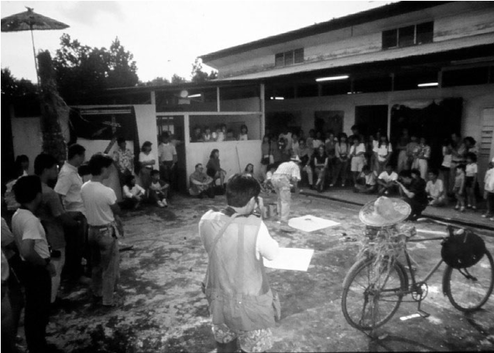
Tang is married to an english woman, Hazel McInotsh. They have got one son, known as Zai Tang, who lived in UK and performs sound art.
In 2005, Tang Da Wu appeared in a documentary television serie, « 4*4 episodes of Singapore artist ». He became a sybol of arts in singapore.
During all his career, Tang received many awards for his works. As i said earlier, it began in 1970 with the drawings and paintings awards given by the Singapore chinese chamber of commerce and industry. It was his first exhbition. The last one is currently happening in the National Gallery of Singapore. The name is « earth work 1979 », it is about painting.
What I have learnt
I would like to explain what i have learnt after working a couple of months on this artist.
Unfortunately I did not have the luck to meet Tang Da Wu during my stay in Singapore. As I said during my few first articles, Mr Da Wu lives and works between Singapore and London. Moreover, the fact he has been re-presented his work “Earth work 1979” at the National Gallery of Singapore from January to June 2016, did not help me have an appointment with him.
I landed in Singapore the 29th of December, 2015. After a few days to discover the city, look for a flat and attend my first courses, I started looking for a contemporary artist in Singapore. Here is a very famous picture that Many people use to describe Singapore for the first time. It shows What theycall the Marina Bay, it is the financial heart of Singapore.
Tang Da Wu really appeared to be my first choice, with no doubt. The fact, that his works are really well known all over Asia and even the world brought some credibility to my work. I wanted to find a Singapore artist whose works have been spread all over the world. I have finally found it And i am proud of it! Here you can enjoy a photo of the famous Tang Da Wu speaking. According to Many people, Tang Da wu was also a good speaker on the stage, another quality.
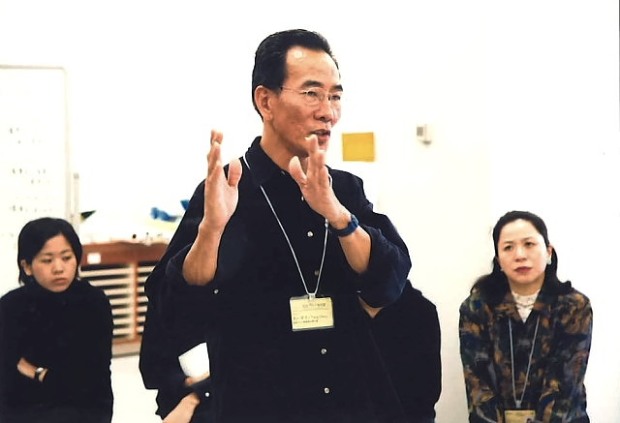
I have never done this kind of work before. At the very beginning, I did not know what to expect from my articles. Does it have to be concise? Do I have to deeply focus on the methods of the artist? Moreover, it is my first time writing a blog. As a matter of fact, I also did not know how to present my blog. Should I take this color or this one? Which one can enhance the purpose of what I am talking about?
Fortunately, it did not take such a long time to adapt myself at this type of work. I started collecting some information about the artist just after I knew Tang Da Wu was my man. I did a very basic presentation on my blog; I simply wanted to catch the attention of the visitors in the first sight. I learnt how to make my paragraph concise and how to emphasize the few key points in very well-constructed sentences.
From an artistic point of view, I am now much more aware of how decrypt a work. The diversity in the work of Tang Da Wu made me able to broaden my point of view and developed analysis skills I tough I never had. Now, when I see a random artist work, I start by analysis what the artist wanted to mean when he dedicated many hours to his work. I try to put myself in his place. Afterwards, I pay attention to the materials used but the artist and how it shows off the work.
To conclude, I just want to say that this work, through my stay in Singapore, help me to think out the box. I want not the most open-minded to art before this specific. Hopefully, throughout the semester, I enhanced my vision of modern art And really feel more confortable with it now! Thanks for pushing me to do this, i really appreciated And i am pretty sure the other students of the Magistère have the same feeling!
Artist working methods
Let’s talk about a more technical aspect of my blog: the methods of Tang Da Wu. Through performance, installation, painting, and drawing, Tang wants to talk about many subject including environmental issues for example. Let’s use the Tiger’s Whip to highlight the working methods of Tang Da Wu: For this work, in part a performance, Tang used a huge amount of papier-mâché in order to make him credible when visitors will see it. Papier-mâché is very simple: sheets and water. In the work’s installation component exhibited in the National Gallery of Singapore, a tiger stands with his two front paws on a wooden chair. Moreover, we can see that Tand Da Wu mixes very different artist style in a single performance. As you can notice, there is red cloth attached to the chair. As I said, the intention of the artist was to make the public aware of what is happening for the tigers in South East Asia. They are tracked down for their genitals because Chinese people find it superstitious: it makes a very good aphrodisiac.
Here is a sample of few aphrodisiac use by chinese people that lead to the increasing number of Tiger deaths.
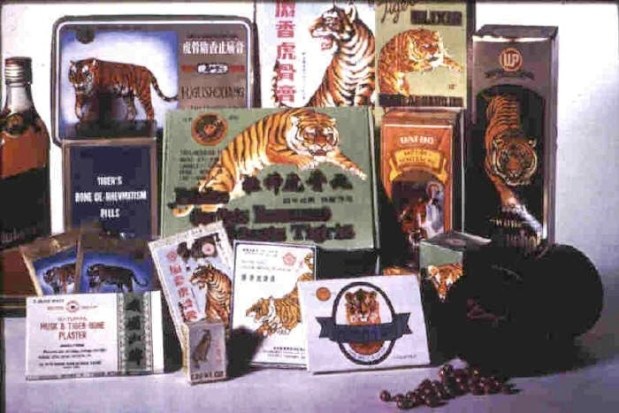
In tang’s paintings, this is a constant exploration of motion and energy, achieved through the use of water and paper as I said before with the tiger.

For example in this painting, we can easily notice the use of that kind of materials. Furthermore, he used to work during the day, saying that, it prefers that rather than after nightfall.
On the other hand, Tang Da Wu is also a performance artist. His implication in all kinds of arts makes him one on the most recognized modern artist in Asia.
In 1980, tang Da Wu staged a work of installation work called earthworks at the national museum art gallery. This installation included 2 works. The first one is “The product of the sun” and the other one is “The product of the rain and me”. They were made with dishes of earth, lumps of soil, and pieces of soiled laundry. He found them in gullies at Ang Mo Kio, a construction site which has been turned into a public housing estate.
In most of the cases, Installation art uses sculptural materials, and sometimes other media such as sound, video and performance, to modify the way a particular space is experienced. It was a way for Tang Da Wu to diversify his work and to entertain people who were coming for his works.
In 1994, the performance artist Josef Ng cut off his pubic hair with his back to the audience during a performance protesting the media’s coverage of gay issues. It resulted in the cease of funding from the national arts council of Singapore. After that, Tang Da Wu and many other performance artists decided to go abroad to perform. Then, most of the performance exhibitions of Tang Da Wu have been performed overseas during this difficult time for the Singaporean Art. Fortunately, he was able to come back and achieve his works in Singapore. Nowadays, he lives and works between London and Singapore
To conclude, we can just say that the works of Tang Da Wu have been much diversified: paintings, drawings, sculpture, and performance. This results of many different methods to achieve his works as I explained through this article.
The Style of Tang Da Wu
We cannot really say that there is only one style corresponding to Tand Da Wu’s works. He has been indeed involved in many works form the paintings to the sculpture. Then, if we focus only on a technical point of view, Tang Da Wu uses many styles. His diversity in his work is also part of his personality. He is famous for that. That is part of his talent And What he is known for.
For example for Tiger’s Whip, he uses papier-mâché for the design of the tiger. On the other hand, he also uses a wooden chair and a red scarf in the same work. He does not focus on one raw material to create what he wants. But stop talking about Tiger ´s Whip. Too Many people only focus on this work but it absolutely does not represent all the insane works that Tang Da Wu during his very long career (And it is not finished!!).
That is why i want to focus now on another type of work, his paintings. We can focus on this painting to emphasize what I want to say. Here is “Kappa playing in the stream”, a painting from 2010.
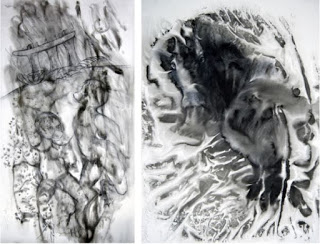
In this painting, Tang Da Wu does not use any color, only the white and the gray. He has created an ambiguous atmosphere. If you take a closer look, you seem to be lost in this painting; it is difficult to perceive what Tang Da Wu wanted to make us feel. By the use of gray and white, and the hazardous contours of the painting, it might be possible that Tang Da Wu only wanted to make us feel lost.
In the following sculpture, Tang Da Wu used steel to represent what looks like a big bird, or a dragon, at the first sight. It is a phoenix. This animal is placed over the lower part of the sculpture which is made of several pieces of mirror. We have seen that Tang Da Wu has been implicated in many environmental issues (tiger hunt…), this work is another example of his commitment in this kind of global issues. The use of steel makes the bird look amazing, powerful and beautiful.
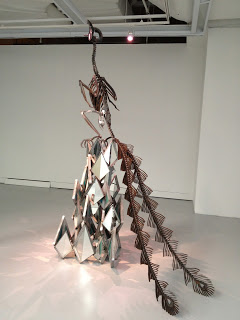
Then as you can see, it is difficult to describe the style of Tang Da Wu. He embraces many styles. That is one the reasons why he is so respected in the art world. He thinks out of the box. It is impossible to reduce him to only one style art when you have a quick look to what he achieved in the past three or four decades. He used to say that the aim of his works was to provoke thoughts (about the environment and social issues, the national identities, etc.), not only entertain the viewer. By saying that, he does not set limits to himself according to the style of his works.
I hope you enjoy this article. More are coming. Enjoy your reading!
« Our Children »
I would like to focus this article on certainly one of most famous work of Tang Da Wu: “Our Children”. Most of the people knowing Tang Da Wu agreed on that point : this is one of his best art achievements!

I begin with a short recap. First of all this work is a sculpture. It has been created in 2012. That is quite recent compared to Tiger’s Whip for example which has been created in 1991. “Our Children” is currently exhibited at the Guggenheim Museum at New-York city. The dimensions are 120 * 200 * 60 cm. Here is a picture of the famous Guggenheim Museum, a very symbolic place for art in the United States Of America.

This work is made of galvanized steel, a glass and milk inside the glass. I decided to choose “Our Children” because I have been impressed by the simplicity of this sculpture. Then, it is only composed of two tables made of steel: the little one below the big one. This is a three-part sculpture, the two tables and the glass full of milk. This work has been quite often shown with a white wall in the back to emphatique this very typical atmosphere.
At first sight, the thing that stroke is the humanity that is created by the curve of the two tables. I personally believe that both of the tables represent two human beings, one children and one parent. My feeling has been strengthened by the name of the work “Our Children” which gave credibility to my theory. Furthermore, after looking on the Internet, I learnt indeed that it represents a baby suckling the milk of his mother. I understood then why the glass of milk was on the table.
One thing I really enjoy in every single work of Tang Da Wu is the presence of Chinese culture and society. We have seen in Tiger’s Whip that he claimed his strong commitment in favor of the spot of massacre of tigers by Chinese. With “Our Children”, Tang Da Wu emphasized the importance of family in the Chinese culture. More precisely, this sculpture decrypts the filiations between the mother and the child. The glass milk is the link between the two.
I find really difficult to show this kind of links with a stationary work. But the fact is, with the glass of milk, and the curve of the table legs, Tang Da Wu did it well, and I liked that. One important think not to forget is the position of the little table: directly under the big one, like a mother protecting her own baby. I have been really amazed by the simplicity of “Our Children”. This simplicity leads to a real power coming from this work. Unfortunately, I have not been able to see it, but I guess that the work is placed in a big empty showroom in order to deepen this feeling.
On the other hand, when I first see the work, I regretted not to see the same kind curves on the top of each table. I guess it could have brought more movement to the work and strengthened the atmosphere of the work.
To conclude, I really like this work. It puts forwards the analyze of the Asian society made by Tang Da Wu.


